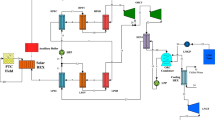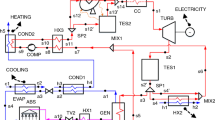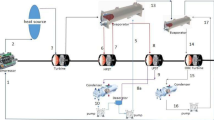Abstract
In this paper, a new multi-generation system is proposed and analyzed through energy and exergy. The new system uses solar power as its energy source and delivers six beneficial productions for the residential sector, such as hotels. These outputs include hot water, electricity, heating, cooling, dry air, and hydrogen production. The effects of some factors such as the inlet and outlet temperature of turbine and ambient temperature on the performances of the system are evaluated. The results show that the energetic COP of the absorption chiller cycle is found to be 60%, whereas the exergetic COP of the absorption system is found to be about 10%. Also, energetic and exergetic efficiency of the organic Rankine cycle is determined to be 8 and 27%, respectively. Moreover, overall energetic and exergetic efficiency of the system is found to be 70 and 53%, respectively.
Similar content being viewed by others
Explore related subjects
Discover the latest articles, news and stories from top researchers in related subjects.Avoid common mistakes on your manuscript.
1 Introduction
In recent times, environmental risks and energy production issues have prompted nations around the world to begin implementing initiatives that focus on creating and using renewable energy sources. There has also been a global push to reduce the current amount of fossil fuels being used (Ratlamwala and Dincer 2013; Ahmadi et al. 2013). This is because fossil fuels are known to release lethal pollutants that are extremely harmful to the environment. Therefore, the application of alternate energy sources such as geothermal, solar, hydropower, nuclear energy, and wind energy is an important step for the future (Ahmadi et al. 2013; Khalid et al. 2015; Kaviri et al. 2013). Solar energy, in particular, has become one of the most popular alternative energy sources because it is free and does not harm the environment (Atikol et al. 2013). Today, there are many power plants which are being run using solar energy. When looking into the different ways of creating power with solar energy, there are a variety of techniques. These include solar towers, solar dishes, and parabolic trough solar collectors (PTSCs). PTSCs have been used in large power plants since the 1980s. Nowadays, many thermal solar power plants choose to work with PTSCs (Al-Sulaiman et al. 2012). A PTSC has been selected for this system because it is able to increase the heat transmission at a faster rate.
Many researchers have worked on the multi-generation systems. Suleman et al. (2014) developed a novel multi-generation system that integrated geothermal and solar. Their results showed that the overall exergetic efficiencies of ORC 1 and 2 are 82.3 and 77.1%, respectively, whereas the energetic efficiencies are 38.3 and 23.2%, respectively. Exergetic COP of the absorption cooling cycle was 0.41, while the energetic COP was 0.77. Furthermore, the overall exergetic efficiency of the cycle was 76.4%, and the energetic efficiency of the system was 54.7%. In their study, Ozturk and Dincer (2013) presented a multi-generation system based on solar and studied energy and exergy analyses. The organic Rankine cycle efficiency was found 13.51%, Rankine cycle efficiency was calculated as 40.94%, utilization system efficiency and hydrogen production were determined as 21.30%, and absorption cycle efficiency was found 32.75%. Energy efficiency of the system was determined as 52.71%, while exergy efficiency of the cycle was determined as 57.35%. Absorption, organic Rankine, Rankine, and hydrogen production and utilization cycles had exergy efficiencies of 14.31, 19.62, 44.88, and 20.32%, respectively. Bicer and Dincer (2015) have designed and analyzed an integrated system for syngas, bitumen, electricity, and hydrogen production at the same time with steam-assisted gravity drainage and underground coal gasification. The proposed system highlights the significance of multi-generation systems. In their study, energy efficiencies of components were determined as 75% for UCG process and 50% for Brayton cycle. Exergy and energy efficiencies of the overall system were 17.3 and 19.6%, respectively. Khalid et al. (2015) developed a new renewable system-based multi-generation through energy and exergy analysis. The overall exergy and energy efficiencies of the proposed system, which use solar energy and biomass, were 39.7 and 66.5%, respectively; on the other hand, the exergy and energy efficiencies were 37.6 and 64.5%, respectively, when the system operated with only biomass, while they were 44.3 and 27.3% when the system operated with only solar.
In this study, the solar power plant is integrated with a dryer and an electrolyzer, as well as SEAS, which generates hot water, heat, dry air, cooling, hydrogen, and electricity. This study proposes a new multi-generation system that uses new working fluids involving 58NaCl_42MgCl2 for parabolic trough solar collector cycle, LiBr–water for the single-effect absorption system (SEAS), and R134a for the drying cycle. As previously stated, this system can be used in the future in the residential sector in places such as hotels.
2 System Description
According to Fig. 1, the system consists of five subsystems such as a single-effect absorption system, a parabolic trough solar collector, a dryer, an electrolyzer, and an organic Rankine cycle (the main productions of the system are dry air, heating, cooling, electricity, hot water, and hydrogen). Solar energy was selected as the source of energy for this study. The parabolic trough collector consists of two components such as collector and receiver, and the heat engine is selected to collect the thermal energy of the solar radiation. The 58NaCl_42MgCl2 is selected as a molten salt to use as a working fluid in PTSC cycle. The organic Rankine cycle consists of six components including a heat exchanger, a pump, a turbine, a condenser, and a steam generator. The working fluid which is in ORC should have high temperature to certify an efficient process. The isobutane is selected as the working fluid for ORC due to the high thermal capabilities and easy availability. Moreover, R134a and LiBr–water are selected as working fluids in the dryer cycle and absorption chiller, respectively.
In this system, solar collectors collect the thermal energy from the sun by circulating molten salt throughout the cycle. When the molten salt is processed in the cycle, it attracts the thermal energy from the sun and becomes hot. Once it has captured the heat, the molten salt will disperse a high-temperature transfer to the isobutene, which is the working fluid in the organic Rankine cycle. This process runs the turbine to produce electricity and can eventually create hydrogen production as well. Moreover, the heat can be transferred to the single-effect absorption system by the generator, which can run the SEAS and produce hot water, cooling, and dry air.
3 Thermodynamic Analysis
In this paper, the following assumptions are made:
-
Air is treated as an ideal gas.
-
The reference environment state has a temperature of \(T_{0} = 297\) K and a pressure of \(P_{0} = 101\) kPa.
-
The turbine is adiabatic.
-
The heat exchangers do not have any heat losses.
-
The pressure losses in all heat exchangers and pipelines are negligible.
-
Moreover, the solar multi-generation system is supposed to operate in a steady-state condition.
According to Dincer and Rosen (2012), the balanced equations for mass, energy, and exergy are defined for major components. Also, coefficients of performance (COP) are determined for the SEAS.
3.1 Rankin Cycle
3.1.1 Turbine
Mass, energy, and exergy balances for the turbine can be written as follows:
3.1.2 Condenser i
Mass, energy, and exergy of the condenser i can be calculated from:
3.1.3 Pump ii
Mass, energy, and exergy balances for the pump ii can be written as follows:
3.1.4 Heat Exchanger i
Mass, energy, and exergy of the heat exchanger i can be calculated from:
3.1.5 Steam Generator
Mass, energy, and exergy balances for the steam generator can be written as follows:
3.1.6 Generator
Mass, energy, and exergy of the generator can be determined from:
3.2 Absorption Chiller Cycle
3.2.1 Heat Exchanger ii
Mass, energy, and exergy of the heat exchanger ii can be calculated from:
3.2.2 Condenser ii
Mass, energy, and exergy balances for the condenser ii can be written as follows:
3.2.3 Pump i
Mass, energy, and exergy of the pump i can be determined from:
3.2.4 Evaporator
Mass, energy, and exergy balances for the evaporator can be written as follows:
3.2.5 Absorber
Mass, energy, and exergy of the absorber can be calculated from:
3.3 Drying Process
3.4 Electrolyzer
where \(\eta_{elec}\) is 0.56 and HHV (higher heating value of hydrogen) is 235.15 (kJ/g-mol).
3.5 The Energetic COP of Absorption Chiller
3.6 The Exergetic COP Absorption Chiller
3.7 The Energetic Efficiency of ORC
3.8 The Exergetic Efficiency of ORC
4 Results and Discussion
Comprehensive energy and exergy analysis of the system has been done, and the results are given in Tables 1 and 2. A comparative study was carried out using results found in similar studies. The effects of energy and exergy efficiency of the components were compared to other similar studies (Islam et al. 2015; Ozlu and Dincer 2015; Ozturk 2012), and respectable agreements are created. In particular, the exergy destruction of some components is compared with the Ozturk system (2012), and the results are shown in the Table 3.
As it is shown in the Table 1, the exergy destruction of the components is less than previous study. All modelings have been carried out by Engineering Equation Solver (EES) software.
4.1 Effect of Turbine Inlet Pressure on Efficiencies
The effects of turbine inlet pressure on the efficiencies of the system are shown in Fig. 2. It can be seen that by growing the inlet pressure of turbine both the overall and ORC efficiencies are falling. When the turbine inlet pressure is increased from 2500 to 5000 (kPa), the overall energetic and exergetic efficiency is decreased from 59 to 64% and the overall exergy efficiency of the multi-generation cycle increased from 69 to 66% and from 52 to 34%, respectively. In addition, the energetic and exergetic efficiency of ORC is decreased from 7 to 4% and from 27 to 24%, respectively. This is because a rise in the turbine inlet pressure produces additional work for the turbine pump.
4.2 Effect of Turbine Inlet Temperature on ORC Efficiencies
The influence of the turbine inlet temperature on the energetic and exergetic efficiency of ORC is presented in Fig. 3. It can be seen that by increasing the inlet temperature of the ORC turbine, the energy efficiency increases quickly while the exergy efficiency does as well, but at a much slower rate. By increasing the inlet temperature of turbine from 530 to 630 K, the energetic and exergetic efficiency of ORC increases from 4 to 31% and from 15 to 92%, respectively. This is due to increase in the inlet enthalpy of turbine and turbine work.
4.3 Effect of the turbine inlet temperature on the turbine work and hydrogen production
Figure 4 shows that an increase in the inlet temperature of the turbine causes a rise in both the turbine work and hydrogen production rate. It can be seen that by increasing the ORC turbine inlet temperature from 530 to 630 (K), the turbine work increases from 87 to 825 kW and also hydrogen production increases from 0.00015 to 0.0016 kg/s because of the increase in the inlet temperature of turbine case an increase in the inlet enthalpy of turbine.
4.4 Effect of the Turbine Outlet Temperature on the ORC Efficiencies
Figure 5 shows that an increase in the outlet temperature of the turbine causes a decrease in the both efficiencies. It is obvious that when the outlet temperature is increased from 460 to 520 (K), the ORC energy efficiency decreased from 24 to 4%. Also, by raising the turbine outlet temperature, the ORC exergy efficiency is decreased from 84% to nearly 14%. It is due to a growth in the exergy destruction of the turbine.
4.5 Effect of Environment Temperature on the Efficiencies
The effects of ambient temperature on the efficiencies are shown in Fig. 6. It can be seen that there is, in fact, no direct effect on the energy efficiency of the ORC and energetic COP because they do not consider heat losses. On the other hand, the rise in the ambient temperature causes a growth in both the exergetic COP and exergetic efficiency of ORC. This is due to decreased temperature difference between ambient and system.
4.6 Efficiencies of Subsystems
The Efficiencies of Subsystems are shown in Fig. 7. The energetic efficiency of dryer, energetic efficiency of electrolyzer, exergetic efficiency of ORC, and energetic COP of chiller are determined to be 48.71, 56, 27, and 60%, respectively.
5 Conclusions
The new multi-generation system, analyzed in this report, is capable of supplying energy to residential sectors such as hotels. It is able to provide the production of heating, cooling, hydrogen hot water, dry air, and electricity. The results of the study show that the energetic COP of single-effect absorption system is 60% while the exergetic COP is 10%. Also, the overall energy efficiency is found to be 70%, while the overall exergy efficiency is determined to be about 53%. Moreover, energy efficiency of the ORC is calculated to be 8%, and exergy efficiency of the ORC is determined to be 27%.
The exergy results, in particular, identify the generator as the component with the greatest exergy destruction rate, meaning that it is the main source of irreversibility. However, the system is inline with the renewable energy initiatives being implemented by the global community and is an important system for the future.
Abbreviations
- \(\dot{EX}\) :
-
Exergy rate (kW)
- Ex:
-
Specific exergy (kJ/kg)
- h :
-
Specific enthalpy (kJ/kg)
- \(\dot{m}\) :
-
Mass flow rate (kg/s)
- P :
-
Pressure (kPa)
- Tb:
-
Turbine
- EG:
-
Electricity generator
- S :
-
Specific entropy (kJ/kg-K)
- t :
-
Temperature (K)
- V :
-
Specific volume (m3/kg)
- abs:
-
Absorber
- Evap:
-
Evaporator
- EV:
-
Expansion valve
- TV:
-
Throttle valve
- SG:
-
Steam generator
- El:
-
Electrolyzer
- LiBr:
-
Lithium bromide
- 1, 2,…,32:
-
State numbers
- d :
-
Destruction
- G :
-
Generator
- P i :
-
Pump i
- P ii :
-
Pump ii
- C i :
-
Condenser i
- C ii :
-
Condenser ii
- HEX i:
-
Heat exchanger i
- HEX ii:
-
Heat exchanger ii
- \(\eta\) :
-
Energy efficiency
- Ψ:
-
Exergy efficiency
References
Ahmadi P, Dincer I, Rosen MA (2013a) Development and assessment of an integrated biomass-based multi-generation energy system. Energy 1(56):155–166
Ahmadi P, Dincer I, Rosen MA (2013b) Performance assessment and optimization of a novel integrated multigeneration system for residential buildings. Energy Build 31(67):568–578
Al-Sulaiman FA, Hamdullahpur F, Dincer I (2012) Performance assessment of a novel system using parabolic trough solar collectors for combined cooling, heating, and power production. Renew Energy 48:161–172
Atikol U, Abbasoglu S, Nowzari R (2013) A feasibility integrated approach in the promotion of solar house design. Int J Energy Res 37(5):378–388
Bicer Yusuf, Dincer Ibrahim (2015) Development of a multigeneration system with underground coal gasification integrated to bitumen extraction applications for oil sands. Energy Convers Manag 106:235–248
Dincer I, Rosen MA (2012) Exergy: energy, environment and sustainable development. Newnes, Oxford
Islam S, Dincer I, Yilbas BS (2015) Energetic and exergetic performance analyses of a solar energy-based integrated system for multigeneration including thermoelectric generators. Energy 93:1246–1258
Kaviri AG, Jafar MM, Tholudin ML, Sharifishourabi G (2013) Modelling and exergoeconomic based design optimisation of combined power plants. Int J Exergy 13(2):141–158
Khalid Farrukh, Dincer Ibrahim, Rosen Marc A (2015) Energy and exergy analyses of a solar-biomass integrated cycle for multigeneration. Sol Energy 112:290–299
Ozlu Sinan, Dincer Ibrahim (2015) Development and analysis of a solar and wind energy based multigeneration system. Sol Energy 122:1279–1295
Ozturk M (2012) Thermodynamics assessment of the multi-generation energy production systems. INTECH Open Access Publisher, Rijeka
Ozturk Murat, Dincer Ibrahim (2013) Thermodynamic analysis of a solar-based multi-generation system with hydrogen production. Appl Therm Eng 51(1):1235–1244
Ratlamwala TA, Dincer I (2013) Performance assessment of solar-based integrated Cu–Cl systems for hydrogen production. Sol Energy 30(95):345–356
Suleman F, Dincer I, Agelin-Chaab M (2014) Development of an integrated renewable energy system for multigeneration. Energy 78:196–204
Author information
Authors and Affiliations
Corresponding author
Rights and permissions
About this article
Cite this article
Sharifishourabi, M., Ratlamwala, T.A.H., Alimoradiyan, H. et al. Performance Assessment of a Multi-Generation System Based on Organic Rankine Cycle. Iran J Sci Technol Trans Mech Eng 41, 225–232 (2017). https://doi.org/10.1007/s40997-016-0057-x
Received:
Accepted:
Published:
Issue Date:
DOI: https://doi.org/10.1007/s40997-016-0057-x











